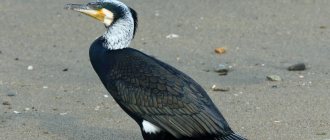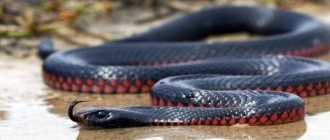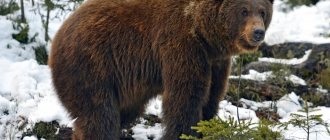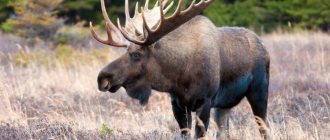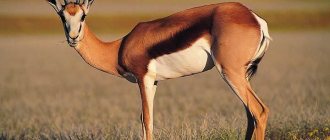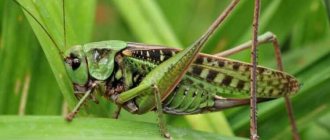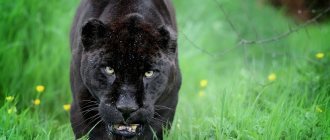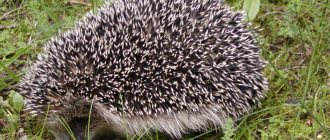Just the sight of an elk evokes a feeling of admiration in a person. A few centuries ago, moose were worshiped, so images of this animal are found in the sarcophagi of ancient burials, as well as in the dwellings of primitive people, such as caves. Moose have always represented strength and endurance. People simply call them “stalkers,” since the shape of the horns bears some resemblance to ancient agricultural tools.
The scientific name “elk” comes from the Old Church Slavonic language and meant “ols”. This concept was associated with the red color of the fur of moose calves. Siberians simply called the animal “beast”. The North American Indians were distrustful of this “beast,” so they retold the legend of the treacherous moose, but the Canadian Indians considered this “beast” a noble animal. In the city of Vyborg there is a monument to an elk, who at the cost of his life saved the lives of hunters who got lost.
Moose: description
The elk is considered a mammal that represents the order of artiodactyls, the suborder of ruminants, the deer family and the genus of moose. The exact number of subspecies of this noble animal has not yet been established, although it is believed that their number reaches 4 or 8. The largest subspecies are considered to be Alaskan and Eastern European, while the smallest is considered to be Ussuri, which has horns that are not characteristic of this animal, without the characteristic blades.
Appearance
Elk is the largest animal of the deer family. The body length of the elk reaches about 3 meters, with a height at the withers of almost 2 meters 40 centimeters. The mass of these animals is at least half a ton, and males are always larger than females.
Elk also has other differences compared to other representatives of this family. For example:
- The moose has a shorter body and slightly longer legs.
- Horizontal, but not vertical arrangement of horns.
- The elk has a hump-shaped wither.
- The animal has a fairly large head with a characteristic hump in front of the nose, as well as a fleshy upper lip.
- In the throat area of the male there is a soft outgrowth of skin, up to 40 centimeters long, called an “earring”.
Since moose have rather long legs, this creates some problems for the animal. For example, in order for an animal to drink water, an elk has to either go deep or kneel down. Although the moose’s fur is hard to the touch, its undercoat is thick and soft, thanks to which the moose can withstand significant cold. In addition, during the winter the moose’s fur grows to almost 10 centimeters. The moose has the longest hair on the withers and neck, so it seems that the moose has a mane and also a hump. The color of the coat on the upper part is more consistent with black, and then this shade becomes brown on the lower part and lighter closer to the legs. In winter, moose are always lighter in color than in summer.
Elk have the largest antlers of any mammal. Their weight can be about 30 kg, and their span is about 1.8 meters. Moreover, such horns grow exclusively on males, since females do not have horns at all.
At the end of autumn, deer shed their antlers and remain antlerless until spring, after which they begin to grow them again. The oldest moose have the most powerful and most “shoveled” antlers.
Interesting fact! The elk does not shed its antlers on its own, but they fall off on their own due to the fact that they have the least amount of sex hormones in their blood. Lack of hormones leads to the weakening of the place where the horns grow, located at the base of the skull. Shed antlers serve as a source of food for various rodents and birds.
Young moose calves develop antlers upon reaching their first year of life. The first horns are quite soft, and they are also covered with thin skin and velvety wool. Over the next two months, the animal has to endure a lot of negative influences, including bites from annoying insects. After this time, the horns become hard, since blood circulation in them stops.
The process of shedding its horns brings significant relief to the animal, since in winter it does not need them, and moving in forest areas with horns, and even more so in winter, when there is a lot of snow, is not so easy.
Coat
Even a brief description of the animal would not be complete without describing the coat, which consists of long, coarse hairs and a softer undercoat. Elk have a fairly long coat. In winter it grows up to ten centimeters in length. On the neck and withers it is even longer and resembles a mane, up to twenty centimeters long. Sometimes it even seems that the animal has a hump.
The soft fur that covers the head even grows on the lips. Only between the nostrils on the upper lip can you see a tiny bare area.
Where does moose live?
Photo: Elk in the forest
The mammal lives in the forest zone, right up to the tundra. After restoring the almost lost population, it settled again in various types of forests, along overgrown mountains, clearings, raised bogs, and along the banks of reservoirs.
In the summer, the ungulate can go far from the forest, wandering into the steppe or tundra zone. Loves aspen, alder, and clearings with abundant grass.
The animal prefers overgrown oxbow lakes, river channels, and shallow lakes, since in the summer they spend a lot of time in the water or near reservoirs, and loves swimming. It grazes in willow forests, but does not really like the deep taiga. The more diverse the vegetation, the greater the chances of meeting elk here. Mammals in mountainous areas inhabit river valleys, gentle slopes, and do not like very rugged terrain. In the Altai and Sayan Mountains, the vertical range fluctuates 1800-2000 m. The animal can wander into char areas where there are lakes with coastal vegetation.
In swamps, the animal moves to places where the land goes far inland, and then moves along islands, crawling across swampy areas on its belly, with its front legs extended forward. In Altai, they carve out a path in the swamp in dry areas, the depth of which is up to 50 cm. These animals live sedentary lives, staying in one place for a long time if no one bothers them and there is enough food. In summer, an individual plot is larger than a winter one. Ungulates can go beyond the boundaries of their land to salt licks. If there are such places in their areas, then animals visit them in the dark 5-6 times a day.
When the possessions of neighboring individuals intersect, at high densities, the mammals calmly tolerate this and do not expel others, as is the case with most deer families. The exception is moose cows during the first period after calving.
What does moose eat?
Photo: Big Moose
This artiodactyl loves tall grass, eats lichens (especially woody ones), and feasts on mushrooms, which are poisonous, from a human point of view. Berries: cranberries, blueberries, and lingonberries are picked and eaten along with the twigs. In the summer, thanks to its high growth, it grabs branches with its powerful lips and rips off the foliage from them.
The elk prefers to feed on leaves and branches:
- aspen;
- rowan;
- bird cherry;
- willows;
- birches;
- ash trees;
- Krushin;
- maples;
- euonymus.
Of the herbaceous plants, the most favorite is fireweed, which grows in abundance in clearings - the favorite places of artiodactyls. Near reservoirs and in the water, it feeds on water lilies, water lilies, marigolds, sorrel, grass grass, calamus, sedge, horsetail and other plants that grow along the banks. In autumn, its diet changes; the animal eats young shoots of trees and bushes, and eats the bark of trees.
With a lack of food, it can gnaw young branches of pine and fir, especially in the second half of winter, but more often it bites branches of willow, aspen, raspberry, birch, rowan, buckthorn, up to 1 cm thick. The ungulate eats bark from young trees during thaws or from the south sides where it heats up and thaws.
In total, the elk’s diet includes:
- up to 149 genera of angiosperms;
- 6 genera of gymnosperms, such as pine, juniper, yew;
- different types of ferns (5 genera);
- lichens (4 genera);
- mushrooms (11 genera);
- algae, such as kelp.
The Evenks call this artiodactyl tree-eater - “moot”, or willow-eater - “shektati”, because it feeds on tree branches. Its common name is “toki,” which superstitious hunters were afraid to use.
During the year, mammals consume up to seven tons of food, of which:
- bark – 700 kg;
- shoots and branches – 4000 kg;
- leaves – 1500 kg;
- herbaceous plants – 700 kg.
In summer, the daily ration can range from 16 kg to 35 kg, and in winter it is about 10 kg. In winter, elk drink little and rarely eat snow, avoiding heat loss, but in summer they can inhale water or aqueous slurry from 15 minutes to an hour, almost without interruption.
Mushroom diet
In addition to salt, the largest deer lack mushrooms. Therefore, after a warm rain or with the onset of autumn, moose go in search of these gifts of the forest. They especially love dry sponge mushrooms - fly mushrooms, boletus mushrooms, porcini mushrooms. Adults remember rich places and visit them from time to time for a new harvest. Incredible but true: moose eat fly agarics! Moreover, it is not this fact itself that is a sensation, but the fact that fungal toxins have no effect on these animals. And moose get their vitamins from berries. They nibble twigs of lingonberries, blueberries, raspberries and blackberries. Realizing that they need to stock up on fat before the onset of cold weather, moose feed heavily in the summer. In warm weather, an adult eats thirty-five kilograms of food, while in winter - only 12-15.
Types of moose
Previously, it was believed that the animal moose constituted one species and all individuals belonged to it. But with the development of genetic research technologies, it was possible to conduct research, the results of which were the division of one species into two and several main subspecies. At the moment, scientists cannot name the exact number of subspecies, since natural processes are taking place, as a result of which the gene pool is changing. It depends on changes in the environment.
Currently the following types are distinguished:
- American . Large representatives of their species. They reach almost maximum dimensions, height 2.4 meters, weight 550 - 580 kilograms. The color of the body, although dark tones, varies in different areas. The top is not monochromatic, but is mixed from brown, red, dark gray shades. The top of the legs and sides may be black. The horns are not as long as those of their brothers, but they are wide. The species lives in the Far East, Mongolia, Siberia, North America, Alaska, and Canada. This species is conventionally divided into subspecies: Alaskan.
- East Siberian.
- Ussuri.
- Eastern Canadian.
- West Siberian.
Sand mole rat
The situation with the sand mole rat is exactly the opposite. On a global scale, this is an endangered species, but in our country it still lives happily. The mole rat has a very small habitat - sand dunes in the Kherson region and a small piece of land in the Nikolaev region. On a planetary scale, this is a tiny territory.
Unfortunately, there are threat factors here too. An increase in air temperature of 1.5-2 degrees is enough, and the mole rat will die, as part of the Kherson region will go under water. Another risk factor is humans. The mole rat lives underground, bothers gardeners, and people consider it a pest.
Molefly - A. Titov / redbook-ua.org
Moose behavior
Moose live in various forests, willow thickets on the banks of steppe rivers and lakes, in birch and aspen forests in the forest-tundra. In summer, they can leave the forests for considerable distances. It is important for the animal to have a swamp, quiet river or lake in its habitat in order to escape the heat and eat aquatic vegetation. In winter, elk prefer mixed and coniferous forests with dense undergrowth. If the snowfall is no more than 30-50 cm, then the elk lives sedentary in such places; if the snow level is above 70 cm, it wanders to less snowy places. It moves to wintering grounds gradually from October to December-January. First, females with cubs leave, then adult males. Every day they are able to walk 10-15 km. In the spring, with the melting of the snow, reverse migration occurs.
The lifestyle of moose depends on the time of year. In summer, they are nocturnal animals, which during the day often hide in the water or in dense forests. In winter, on the contrary, grazing occurs during the day, and at night the moose lie down. In severe frost, they lie down in the snow, leaving only their heads outside. In winter, moose trample snow in areas called camps; several individuals use them for feeding.
Elk can run fast, reaching speeds of up to 56 km/h, and swim well. Can submerge under water for about a minute. It defends itself from predators by striking its front legs. The animal has well-developed hearing and sense of smell, but its vision is weak.
Moose breeding
Moose of both sexes usually live alone or in small groups of 3-4 individuals. In summer and winter, adult females with elk calves, as well as males, gather in herds of up to 8 individuals. In the spring, such groups break up.
The mating season for moose is September-October. At this time, the males begin to roar dully, as if moaning; they are excited and aggressive, often attacking people. Males engage in fights among themselves, often with fatal results. Elk are considered a conditionally monogamous animal, usually mating with only one female.
The duration of pregnancy is 225-240 days, births occur from April to June. One cub is born, and occasionally twins. The newborn is colored light red, there are no white spots. Elk calves stand on their feet within a few minutes after birth, and at the age of 3 days they move freely. Females feed them with milk for the first 3.5-4 months of life.
Puberty in young animals occurs at the age of 2 years. In nature, moose live 10-12 years; in captivity, their life expectancy increases to 20-22 years.
Little gopher
— Over the past 10 years, gophers have disappeared from the controlled territory of Ukraine. There are only a few individuals in Crimea. Before the war, gophers lived in the Donetsk and Lugansk regions, but now nothing is known about them. In Kazakhstan, the small gopher is doing quite well, but here we have a catastrophic decline for unknown reasons,” complains Mikhail Rusin.
Small gopher – Oleg Mileev (Kamintsev) / ru.wikipedia.org
Behavior and lifestyle
These animals prefer to lead a sedentary lifestyle, remaining constantly in one place if there is enough food and comfort. When they begin to migrate, it is likely that they do not have enough food. Moose do not like it when there is a lot of snow, so they spend the winter in places where the thickness of the snow cover does not exceed half a meter. In search of suitable places for wintering, females and their offspring go first, followed by males. When animals return from wintering, the males go first, followed by all the other members of the family.
Within one day, moose travel up to 15 kilometers, while they run well, reaching a speed of almost 60 km/h.
Moose do not lead a gregarious lifestyle, so groups of moose can consist of no more than 4 individuals, and most often they live separately. In conditions of small groups, moose can be seen only in winter, so with the onset of spring, moose again scatter in different directions. Places where moose gather for the winter are called “camps” or, as in Canada, “yards”. Often in one “yard” you can count up to a hundred individuals.
The activity of moose depends on many factors, but the main one is the ambient temperature. When it’s hot during the day, moose hide from the heat, as well as from annoying insects, in water or in ventilated forest clearings, as well as in dense thickets. Therefore, in the summer, moose feed mainly at night.
With the onset of winter, everything turns out the other way around, and the moose feed during the day, because at night they have to warm themselves from the cold. To do this, they are immersed in the snow almost completely so that only the ears and withers are visible from the snow. If the body temperature drops to 30 degrees, the moose may die from hypothermia.
When the breeding season begins, moose are active both during the day and at night.
Important point! If a moose is forced to run quickly in hot weather, its body temperature can rise to 40 degrees, which can lead to heatstroke. This can happen thanks to a special natural repellent that is produced in the animal instead of classic sweat - “fat sweat”.
This natural component helps the animal protect itself from the bites of various insects, saves it from the cold, but negatively affects the elk’s body during the heat. This secretion clogs the skin pores, which prevents the body from cooling quickly because heat exchange is disrupted.
Moose have excellent hearing, but not so excellent vision, since they are not able to discern a human figure even from 20 meters. Moreover, moose are excellent swimmers. Water for them is an element of salvation (from insects), as well as a source of food. These animals can easily swim in water up to 20 km and can stay under water for at least 1 minute.
Moose are not considered conflict animals, but during the breeding season their level of aggression increases significantly. It is during the breeding season that moose use their antlers as an argument in the process of fighting for females. When attacked by a wolf or bear, these animals defend themselves with their front legs. In any case, moose do not attack first and, if possible, immediately run away.
Lifespan
Nature has set a lifespan of about a quarter of a century, although they do not live up to 12 years, since elk have many natural enemies, including humans, who hunt the animal for commercial purposes.
Natural enemies of moose
Photo: Elk with antlers
Among the elk's main enemies are bears. Most often they attack artiodactyls when they awaken from hibernation. They often chase pregnant females or attack moose calves. Mothers protect their young. A blow from the front limbs is especially dangerous. In this way, an ungulate can defeat a bear or any enemy on the spot.
Wolves are afraid to attack adults; they do so in a pack and only from behind. Most often, children die from gray predators. In a snowy winter, wolves cannot keep up with an elk, even a young one. Through a brown, dense forest or during spring return colds, a flock can easily drive a calf or an emaciated adult. Huge artiodactyls cannot resist the lynx or wolverine, which guard their prey in ambush in a tree. Throwing themselves from above, predators grab onto the neck, cutting through the arteries.
Summer midges, horse flies and gadflies are very annoying to moose. Their larvae can settle in the nasopharynx. When there are large numbers of them, difficulty breathing occurs, the mammal becomes exhausted, as it is difficult for it to eat, and sometimes dies. Horsefly bites cause non-healing ulcers on the legs of animals that bleed.
According to eyewitnesses, there were years when animals, tormented by midges, came out to their homes without reacting to dogs or people. Residents of the villages doused the bitten animals with water and fumigated them with smoke, but they could not save everyone from death.
Population and species status
Photo: Animal moose
Due to excessive fishing, the fairly stable population of the largest forest ungulates began to decline since the 19th century. By the beginning of the last century, the animal was exterminated, or almost disappeared, in many regions where it was found previously, both in Eurasia and North America. Temporary bans on hunting and conservation measures led to the gradual restoration of former habitats. Camisoles and riding trousers, which were called “elks”, were previously made from elk skin.
At the end of the 20s, in many regions of Russia no more than a few dozen individuals could be counted. Decrees banning fishing (except in Siberia) led to an increase in the number of livestock in the late 30s. Animals also migrated to more southern regions, where young forests appeared in places of fires and deforestation.
During the Great Patriotic War, the number of artiodactyls in the European part of Russia again decreased significantly. In 1945, a ban on hunting was introduced, and a brutal fight against wolves began. The reduction in the number of gray predators, the organization of protected areas, and the introduction of licensed fishing were the decisive factors that influenced the noticeable increase in the population.
The number of wild ungulates on the territory of the RSFSR was:
- in 1950 - 230 thousand;
- in 1960 — 500 thousand;
- in 1980 — 730 thousand;
- by 1992 - 904 thousand.
Then there was a decline and by 2000 the number was 630 thousand individuals. With a much smaller range, at the same time in the North. There were up to 1 million moose in America, 150 thousand in Norway, 100 thousand in Finland, 300 thousand in Sweden. And this was in countries where the animal had previously been almost exterminated. The global conservation status of this animal is designated as “least concern.”
In Russia, according to experts, even taking into account the interests of forestry, it is possible to increase the elk population to 3 million; now their number is about 700-800 thousand. Although this animal is not in danger of being destroyed, it is worth taking increased care for its safety and increasing its population. Elk can live in captivity to obtain dietary meat, leather, antlers and milk.
Bison
It is believed that the last wild bison was killed during the First World War. When there were no bison left in the wild, few animals still lived in zoos. They began to crossbreed to increase the population. Gradually, the bison began to be released into the wild.
In Ukraine, bison were released in Polesie - in the Zhytomyr, Sumy, and Chernivtsi regions. Thanks to such actions, the population was preserved. Now bison live mainly in nature reserves and parks in Belarus, Russia, the Caucasus and Poland. Their numbers are growing all over the world, except Ukraine. Most likely, poachers are to blame.
Bison - Michael Gäbler / ru.wikipedia.org
Status and commercial value of moose
In the old days, moose were hunted for their meat and skin. This led to disastrous consequences for the animal population. In the modern world, the problem of poaching still remains, but now there is an alternative to wild hunting. This is elk farming. On such farms they breed species adapted to life in captivity. Animals are looked after there and excursions are conducted. In the future, options are being considered for creating farms aimed at raising moose like cattle for further use as a source of meat. This is supported by the fact that the animal quickly gains weight, does not require special feed, and eats what is under its feet. Does not compete with other livestock on pastures; it can graze where conditions are unsuitable for other species.
European ground squirrel
Lives in Hungary, Germany, Bulgaria, Romania, Turkey. Here - in Transcarpathia, in Vinnytsia and Chernivtsi regions.
— In 2009, the Red Book noted that there were no European ground squirrels left at all, but then our colleagues from the Chernivtsi region reported that a ground squirrel had been found. We arrived and confirmed this information. Sometimes this happens with small species - they can get “lost,” says Rusin.
But in any case, if scientists do not find a species for a long time, it means that there are too few of its individuals left.
European ground squirrel – BS Thurner Hof / ru.wikipedia.org
Nutritional qualities of elk
Elks are a source of two foods at once, meat and milk. Moose cows milk well, their milk is not as sweet as that of cows, but it is fattier. It is used mainly as a special nutritional supplement and for medical purposes. The meat of the animal is tough, it does not contain as much fat as other representatives of cattle. The best option for using meat is to prepare canned meat, stewed meat, corned beef, and raw smoked sausage from it. To prepare various dishes, preparations are taken from young individuals up to 3 years old, preferably females. Their meat is more tender and soft, and is easier to process.
Before preparing the dish, the tenderloin is soaked and marinated for a long time to soften the structure and saturate it with flavor. You can cook excellent soups and broths, bake with herbs, vegetables, fry chops or steaks, stew with mushrooms, potatoes, and vegetables. The taste of elk is also well complemented by sauces made from fresh berries, sweet and fragrant.
Elk meat is a healthy product. The animal is kept in its natural environment, eats environmentally friendly products, and monitors the condition of its body. Meat is rich in fluorine, phosphorus, iron, iodine, sodium, selenium, zinc, and calcium. It also contains a lot of vitamins of the PP group, B 1-2-5-6-12. It is especially useful for sick and weakened people to use it. This way they can quickly regain their strength and get better.
Horns
The biggest pride of a moose is its antlers. It was because of them that he became prey for humans. Even in ancient times, elk antlers in the house were considered the main prey of a hunter; they were a symbol of dexterity and good luck in hunting. The weight of such horns can reach an average of 20 kg and this is not surprising, because their span is almost two meters.
The base of the horns is a short trunk and a spade-shaped branch on which 18 branches are located. The elk's horns are individual. The size and location of the processes are distinguishing features between animals. Usually the adult representative has the most massive and heaviest shoots, but a small moose can boast of its horns only after its first birthday. Initially they are soft, the base is covered with thin skin and short, delicate fur.
During this period, young individuals suffer from insect bites as they bite through the horns, reaching the blood vessels running inside. After about a year or so, the horns harden so much that active blood circulation in the tissues stops. From this moment on, the horns grow in width, and after five years the width of the shovel will be significantly larger than the shoots. At this age, the horns of a young individual become similar in shape to the horns of an adult.
Why does a moose shed its antlers?
Usually by the onset of winter the animal sheds its antlers. This is an absolutely painless procedure that brings him relief. To free itself from its antlers, the elk actively rubs them against trees, after which the antlers fall off. In the spring it grows new antlers, which harden in July. By the way, only males have horns, while females are deprived of such decoration.
There is an opinion that antlers are needed to protect the elk in the forest from other animals, but this is not true. The main purpose of the horns is to attract a female during the mating season and protect her from other males. As the mating season passes, the horns become unnecessary. Shedding antlers for winter makes wintering much easier - it is easier for the animal to move around and find shelter.
The immediate cause of the loss of horns is a decrease in the amount of sex hormones produced in the animal’s body. As a result of hormone deficiency, special cells are activated at the base of the horns that can have a destructive effect on bone tissue. It is thanks to their work that the horns weaken significantly and then disappear altogether. The elk's horns become an important food source for forest animals - squirrels, birds and predatory animals eat the protein, which is contained in abundance in the horns.
Salt fasting
Probably, foliage, needles, bark and shoots do not fully satisfy the needs of these large artiodactyls for useful substances. Since it is a wild animal, it must search for a source of salt on its own. Without it, the animal gets sick. Therefore, in the summer, moose come out of the forests and look for salt licks. There they lick the soil, saturating the body with this mineral. In winter, elk go out onto major highways in search of salt, knowing from experience that the asphalt forms a solution necessary for health. To prevent road accidents, foresters, knowing what the elk eat, mix crystals into the food or leave compressed cubes in the thicket.
Interesting facts about moose
- Elk is a valuable game animal; its meat and skin are used. In Russia and Scandinavia, they tried to domesticate the animal and use it as a riding and dairy species, but it turned out to be difficult to maintain and therefore this idea was abandoned. In Russia, there are special moose farms where they conduct excursions for everyone who wants to see this forest giant.
- Moose milk tastes like cow's milk, but it is fattier and not as sweet. It is used in medical nutrition.
- Elk meat is tough and not as fatty as that of most of its relatives. Used in the production of canned food and raw smoked sausage.
- There are sculptural monuments to elk in Vyborg, Moscow and Monchegorsk.

